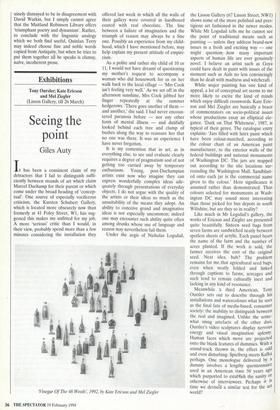Exhibitions
Tony Oursler; Kate Ericson and Mel Ziegler (Lisson Gallery, till 26 March)
Seeing the point
Giles Auty
It has been a consistent claim of my detractors that I fail to distinguish suffi- ciently between strands of art which claim Marcel Duchamp for their parent or which come under the broad heading of 'concep- tual'. One source of especially vociferous criticism, the Karsten Schubert Gallery, which is located more obscurely now than formerly at 41 Foley Street, Wl, has sug- gested this makes me unfitted for my job. A more 'serious' critic than I would, in their view, probably spend more than a few minutes considering the installation they
offered last week in which all the walls of their gallery were covered in hardboard coated with real chocolate. The line between a failure of imagination and the triumph of reason may always be a fine one. Possibly an experience from my child- hood, which I have mentioned before, may help explain my present attitude of empiri- cism.
As a polite and rather shy child of 10 or 11, I would not have dreamt of questioning my mother's request to accompany a woman who did housework for us on her walk back to the local village — 'Mrs Cook isn't feeling very well.' As we set off in the afternoon sunshine, Mrs Cook jabbed her finger repeatedly at the summer hedgerows. 'There goes another of them and another,' she said. I had never encoun- tered paranoia before — nor any other form of mental illness — and dutifully looked behind each tree and clump of bushes along the way to reassure her that no one was there. It was an experience I have never forgotten.
It is my contention that in art, as in everything else, to see and evaluate clearly requires a degree of pragmatism and of not getting too carried away by temporary enthusiasm. Young, post-Duchampian artists exist now who imagine they can express wonderfully complex ideas ade- quately through presentations of everyday objects. I do not argue with the quality of the artists or their ideas so much as the unsuitability of the means they adopt. An ability to conceive grand and imaginative ideas is not especially uncommon; indeed one may encounter such ability quite often among drunks whose use of language and reason may nevertheless fail them.
Under the aegis of Nicholas Logsdail, 'Vinegar Of The 48 Weeds; 1992, by Kate Ericson and Mel Ziegler the Lisson Gallery (67 Lisson Street, NW1) shows some of the more polished and pres- tigious art fashioned in the newer modes. While Mr Logsdail tells me he cannot see the point of traditional means such as painting — unless they address brand-new issues in a fresh and exciting way — one might question . low many important aspects of human life are ever genuinely • novel. I believe an artist such as Goya could have dealt in paint with issues of the moment such as Aids no less convincingly than he dealt with madness and witchcraft.
While major painting has one kind of appeal, a lot of conceptual art seems to me more likely to excite the kind of minds which enjoy difficult crosswords. Kate Eric- son and Mel Ziegler are basically a brace of commentators on socio-political issues whose productions essay an elliptical ele- gance. 'Dark on That Whiteness', 1987, is typical of their genre. The catalogue entry explains: 'Jars filled with latex paint which have been colour-matched, according to the colour chart of an American paint manufacturer, to the exterior walls of the federal buildings and national monuments of Washington DC. The jars are mapped out according to the site locations sur- rounding the Washington Mall. Sandblast- ed onto each jar is the commercial name given to the colour.' Here significance is assumed rather than demonstrated. Thus colours selected for monuments at Wash- ington DC may sound more interesting than those picked for bus depots in south Wiltshire, but are they so in reality?
Like much in Mr Logsdail's gallery, the works of Ericson and Ziegler are presented quite beautifully. Sixteen seed bags from seven farms are sandwiched neatly between spotless sheets of acrylic. Each panel bears the name of the farm and the number of acres planted. If the work is sold, the farmer receives the cost • of the original seed. Neat idea, huh? The problem remains for me.that agricultural seed bags, even when neatly folded and linked through captions to farms, acreages and such tend to remain culturally inert and lacking in any kind of resonance.
Meanwhile u third American, Tony Oursler sets out to describe through his installations and watercolours what he sees as the final fate of media-based, consumer society: the inability to distinguish between the real and imagined. Unlike the some- what smug artefacts of the other duo, Oursler's video sculptures display nervous energy and visual imagination aplentY. Human faces which move are projected onto the blank features of dummies. With a sound-track thrown in, the effect is odd and even disturbing: Spielberg meets Kafka perhaps. One monologue delivered by a dummy involves a lengthy questionnaire used in an American state 50 years ago which purported to establish the sanity 9r otherwise of interviewees. Perhaps it is time we devised a similar test for the art world?


















































 Previous page
Previous page